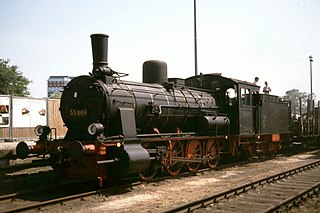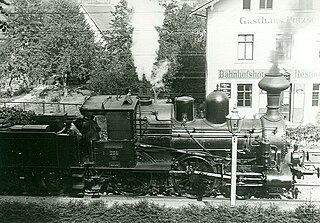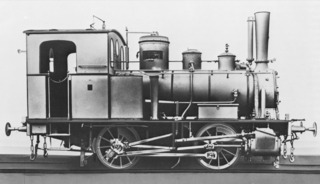The Pt 2/4 H was a class of steam locomotive built by the firm of Krauss for the Royal Bavarian State Railways between 1906 and 1908. They were used on routes in Bavaria to haul light, fast passenger trains.
The little D IV was one of the most frequently seen tank locomotives in the stations of the Royal Bavarian State Railways. The Deutsche Reichsbahn took over almost all of them, 124 in total, of which 24 were from the Palatinate (Pfalz).
The Bavarian Class G 4/5 N was an early twentieth century German 2-8-0 steam locomotive built for the Royal Bavarian State Railways (K.Bay.Sts.B.). Its design was based on that of the Class E I and it had unmistakable similarities to the final series of that class. Had the K.Bay.Sts.B. not changed their locomotive classification system just before this engine was produced it may well have entered service as the latest variant of E I.

The goods train locomotives of Class C VI were German steam engines built between 1899 and 1905 for the Royal Bavarian State Railways. It had great similarity to the Prussian G 5.4, but had a higher boiler overpressure and better riding qualities. In all the Bavarian state railways procured 83 engines of this type over that period. More machines with slight modifications were acquired between 1907 and 1909. These 37 engines were given the designation G 3/4 N. The Deutsche Reichsbahn inherited 64 Class C VI and 32 Class G 3/4 N engines. These were given operating numbers 54 1301–1364 and 54 1401–1432. The Class C VII locomotives remained in service until 1931, their Class G 3/4 N sister locomotives until 1935.

The C IV was a steam locomotive, built for goods train duties, that was manufactured between 1884 and 1897 for the Royal Bavarian State Railways.
The German Class 87 was a standard goods train tank locomotive with the Deutsche Reichsbahn-Gesellschaft (DRG). It was specifically designed by the firm of Orenstein & Koppel for use in Hamburg Harbour. The harbour lines had minimal curve radii of only 100 metres (330 ft) and high train loads to be moved. The axle load had to be no more than 17.5 tonnes. These requirements resulted in an axle count of five axles. In order to keep wear and tear on the running gear within acceptable limits only the middle three wheelsets were linked by coupling rods, the two Luttermöller outside axles were driven by cogs.

The DRG Class 89.0 was a goods train tank engine of standard design built for the Deutsche Reichsbahn (DRG).
The German DRG Class 71.0 was a 2-4-2T locomotive with the Deutsche Reichsbahn, which was intended as a replacement for railbuses. Originally it had been planned for these standard engines (Einheitsloks) to haul fast passenger trains.
The Bavarian Class D IV was a German steam locomotive with the Bavarian Eastern Railway.

Between 1934 and 1941 the Deutsche Reichsbahn (DRG) converted a total of 691 former Prussian-built Class 55.25–56 steam locomotives; the result was the DRG Class 56.2–8. The carrying axle enabled higher speeds and the engine could even be used as a passenger train locomotive. In addition the average axle load was lower, so that these locomotives could also be used on branch lines. The conversion entailed moving the boiler forward and raising it somewhat. The vehicles were given operating numbers between 56 201 and 56 891, although the numbering was not continuous.
The Oldenburg G 4.2 steam locomotives were goods train engines built for the Grand Duchy of Oldenburg State Railways between 1895 and 1909 in several series.

The Oldenburg G 7 steam locomotive was a German 0-8-0 locomotive produced for the Grand Duchy of Oldenburg State Railways. It was an eight-coupled engine, intended for heavy goods train duties, and was based on the Prussian G 7. It had a 1,660 mm diameter boiler located 2,820 mm above the top of the rails in the plate frame, and was equipped with a single Walschaerts valve gear as well as a Lentz valve gear. Thirteen were taken over by the Deutsche Reichsbahn, grouped into DRG Class 55.62 and given numbers 55 6201–55 6213.
The Saxon Class IX was a class of German, eight-coupled, tender locomotives built for the Royal Saxon State Railways for goods train duties.

The Saxon Class III b were German steam locomotives built for the Royal Saxon State Railways in the late 19th century as tender locomotives for express train duties. In 1925, the Deutsche Reichsbahn incorporated the engines into DRG Class 34.77-78.
The Prussian Class G 4 were German, six-coupled, goods train, steam locomotives with a boiler pressure of 12 bar, built primarily for the Prussian state railways. Classified by the state railway in 1905, they included 16 locomotives from the railway division of Mainz, that originally came from the Hessian Ludwigsbahn. These earlier locomotives were delivered between 1872 and 1896 and did not meet the Prussian norms.

The Baden Class I e locomotives with the Grand Duchy of Baden State Railways were twin-axled tank engines that were built by the Maschinenbaugesellschaft Karlsruhe for duties on branch lines.
The Mecklenburg Class G 3 was an early German steam locomotive operated by the Grand Duchy of Mecklenburg Friedrich-Franz Railway. Formerly the Class IX it was a copy of the Prussian G 3.
The Mecklenburg Class G 4.2 operated by the Grand Duchy of Mecklenburg Friedrich-Franz Railway was a goods train, steam locomotive with a compound engine. It was procured between 1901 and 1905 from Henschel and Linke based on the Prussian G 4.2 prototype. A total of five machines were built for Mecklenburg. It was planned that they would be taken over by the Deutsche Reichsbahn and were to have been given numbers 53 401 to 53 405 according to the 1923 provisional DRG renumbering plan. But they were retired by 1924 before the final plan was issued.







